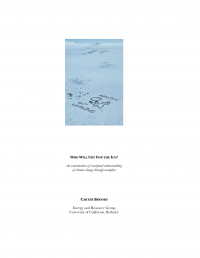For the artistically minded, the best way to solve a problem is indirectly. How many great discoveries have been accidents? How often do we set out on one course and arrive at an unexpected destination? So, perhaps the best way to address the climate crisis is to address something else. This is why I often say that I’m not interested in solving our climate change crisis. The crisis that needs solving is the crisis of the human imagination.
John Jeavons, an activist biodynamic farmer used to give a talk about agriculture in which, after thoroughly convincing the audience of the importance of learning to grow crops, he would say, “But once you have learned to grow crops, I want you to stop growing crops. I don’t want you to grow crops ever again. Instead I want you to grow soil.” That is, grow soil that will grow good crops. He would then state the obvious—that to grow good soil not only makes it easier to grow good crops, but also requires knowing how to grow crops. Then he’d stop and do it again. “I want you to stop growing soil. I want you never to grow soil again. What I want you to grow are people. People who know the importance of growing soil.” The lesson is no different with climate change. We don’t need to stop emitting greenhouse gasses. We need to grow people, cultures even, that know not to.
We currently have a crisis of the imagination. When our politics cannot imagine a way to harness clean energy without being in conflict with economic well being, then we have a crisis of imagination. When we have a populace fed awareness through a television, a populace wandering about muttering the talking points of the dominant party, we have a crisis of the imagination. When climate change is reduced to an issue of fossil fuel emissions thickening a carbon blanket, we have a crisis of the imagination.
But the question of the imagination goes beyond the collective human mind. There is more to imagination that just thinking. The landscape is an imagination. The thousands of insect species, bacteria, and other life forms playing out the game of life and death on any tree on any day is expression of imagination. The shape of mountains carved by rivers of ice is an expression of imagination.
Meanwhile, how many species a day are currently being driven to extinction? This is a crisis of imagination. Around the globe, the floor of the oceans to depth of 600ft. has been bulldozed by dragging trawler nets. This is a crisis of the imagination. The crops that feed humanity have been reduced to a few hundred from tens of thousands. This is a crisis of the imagination. The ethnosphere of language and culture is in a state of genocide. This is a crisis of the imagination. The white peaks that wear down the mountains are vanishing. This is a crisis of the imagination.
In the middle of this crisis of the imagination, I wonder what it means that the great ice rivers and ice sheets of the Earth are melting away. Before I am a grandfather, the ice of Kilimanjaro will be gone. When my daughter is a grandmother, Santa’s ice cap will be a watery nothing in the summer months. In my lifetime, the CO2 concentrations in the atmosphere have reached levels the earth has not seen in 55 million years.
And today it requires imagination to notice the missing question: what does it mean?
The crisis is of imagination. It is the war. “The only war that matters,” as the great poet
Diane DiPrima repeats and repeats.:
There is no way out of the spiritual battle
the war is the war against the imagination
you can’t sign up as a conscientious objectorthe war is the war for the human imagination
and no one can fight it but you & no one can fight it for you

 “Who Will Cry for the Ice?”
“Who Will Cry for the Ice?”